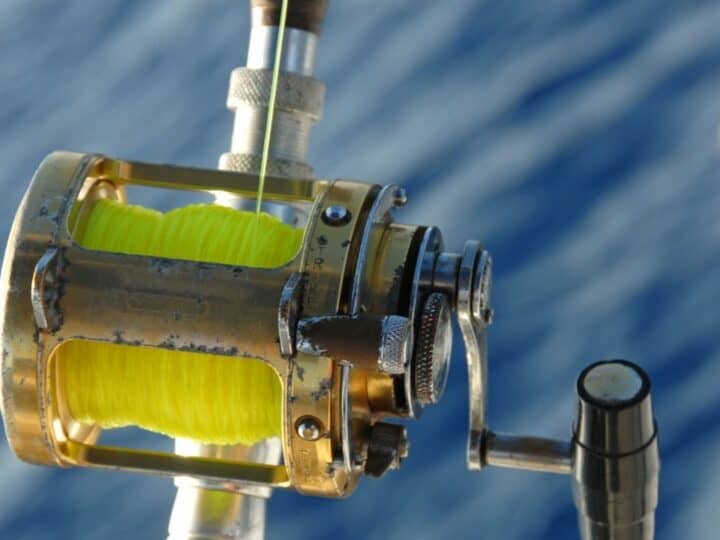Your fishing rod spinning reel has a bail mechanism that allows the fishing line to spool backward (in) and forwards (out).
When you cast your line, you need the fishing line to spool out. However, fighting a fish mustn’t spool out so far that you lose your fishing line to the fish.
Every spinning reel has a bail wire (a short, thin, metallic, U-shaped wire) that should control the reel.
An open bail means you can cast your line. When it is closed, the wire is the only thing you should be reeling in.
In the closed position, the fish you are fighting ought not to be able to run out the line.
If the bail is locked, but your fishing line can still spool out, then your reel isn’t locking – and there’s a problem somewhere.
How to Fix a Fishing Reel that Won’t Lock
First, check your reel for broken bail wire, spool gear, anti-reverse, and drag system. If it’s the bail wire or the spool gear, replace them with new ones. If the drag system is the problem, try increasing the drag. If not, replace the broken components and reassemble them. For anti-reverse system problems, have a professional fix them as they’re more complicated.
Check for a Broken Bail Wire or Damaged Spool Gear
You should check for this issue first because it is the most common problem with reels that won’t lock.
Equipment Needed:
- A pair of pliers
- A set of small screwdrivers (If you have screwdriver-like accessories from your reel’s manufacturer, so much the better.)
Tip: Many of the small parts in your reel cannot be fixed if broken. Be prepared to buy replacements for them.
Step 1: Remove the Bail Wire
Use one of the screwdrivers to remove the small screw on the pivoting arm holding the bail wire in its place.
If this is enough for you to gain access to the bail mechanism, then fine. If not, remove the screw on the bail wire’s remaining connected arm.
Next, inspect the screw (or screws) to see if it is still in good condition. A damaged screw can mess up the bail wire’s locking action quite quickly.
If the screw(s) is undamaged, carefully put it aside as you will need it again when reassembling your reel.
If the screw is damaged, get a replacement screw. Don’t try to fudge a fix, as this is more than likely to go wrong in the middle of your next fishing trip.
Step 2: Inspect the Bail Wire
Next, take out the bail wire and inspect it for any signs of damage.
Your reel will stop locking if the bail wire is rusty, corroded, or snapped, so these are clear indications of damage to look out for.
Tip: If the bail wire is broken in any way, just change it.
Don’t try to fix it.
Step 3: What to Do if the Bail Wire is not the Problem
If the bail wire is not the problem, then the next natural suspect is the line roller.
Inspect this element for signs of corrosion or damage. It is elementary for a broken line roller to wreck your fishing reel.
To see if the problem is your line roller, take out the screw that holds it in its place and inspect it closely for wear and tear or damage.
If you find any impairment, you will simply have to replace the line roller. Line rollers cannot be repaired.
Step 4: What to Do Next if it’s Not the Bail Wire or the Line Roller
If neither the line roller nor the bail wire (or the bail wire’s holding screw(s)) is damaged, then the problem could be with the bail wire’s springs.
So the next step is to remove the spring (which will always be the side of the bail spring that pivots).
As mentioned earlier, the most common problem when a spinning reel won’t lock is the bail wire or spool gear, and the spring is the most frequent culprit.
Spring should not ever be rusted, bent, broken, kinked, or damaged in any way.
The same as many of the bail’s other components, if the spring is damaged, you will just have to replace it.
Step 5: Reassemble your Reel
After all the parts have been checked and replaced, simply reassemble your reel in the order you disassembled it.
One thing to remember is that even though you’ve fixed everything you found damaged, your reel still might not lock.
Don’t be alarmed. It happens.
There are still two more common-ish issues to check out before you have to think about replacing your reel.
If your Reel’s Drag System is Kaput, Fix it
Tip: Fixing the drag system is best done with a helping hand. It is tough to try and repair it on your own.
If the spool isn’t locking and is letting out line easily, the drag might be what you have to correct.
Correcting the drag is relatively simple as long as you have someone to lend you a hand.
The first usual suspect is the drag setting. It might be too low.
Increase the drag to check to see if this is the cause.
If not, it could be an internal problem with the drag’s spring or knob, and fixing this is far more complicated.
If you’re willing to try, open the drag system using the screwdriver.
Remove and examine the drag’s knob, the spring, washers, fiber, spring clip, and other internal bits and pieces.
Replace broken components and reassemble the drag system.
Tip: Admittedly, fixing the drag system may be more readily understood with a demonstration.
Click here to watch a video on fixing a reel’s drag system.
Fix your Reel’s Anti-reverse System
Look, I’m going to come clean with you. Repairing a spinning reel’s anti-reverse system by yourself requires some level of expertise.
But, as you’re reading this article, you’re not quite there yet. I’m not trying to put you down.
I’m trying to save you a boatload of angst.
If you are still determined to go ahead with repairing the anti-reverse system, then click here to watch a video guide.
Good luck!
Frequently Asked Questions about How to Fix a Fishing Reel that Won’t Lock
Why can’t I lock my reel?
In the main, your reel won’t lock for two reasons: it either has a broken spool or something has gone wrong with its bail wire. Other reasons your reel won’t lock happen less often: problems with the drag system or anti-reverse and a tangled-up fishing line.
What does the anti-reverse do on my fishing reel?
The anti-reverse feature on spinning reels prevents coils from turning backward. Some reels include an anti-reverse switch that is activated automatically. Anti-reverse is used to fight with larger fish rather than put the fisherman through the strain of using back-reel.
Afterword: How to Fix a Fishing Reel that Won’t Lock
It can be tricky to work out how the inner gears of a fishing reel work. However, with dedication, learning’s possible.
Although it may seem complicated at first, once you’ve spent a few days fixing a fishing reel that won’t lock, you’ll soon get the hang of it, and the rest will become easy.

